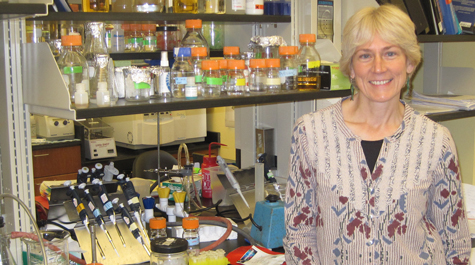W&M biologist receives $1 million to study ‘intracellular traffic control’
William & Mary molecular biologist Lizabeth Allison has received a grant of more than $1 million from the National Science Foundation (NSF).
Allison is Hamilton Professor and chair of the College’s Department of Biology. The four-year NSF grant of $1,064,582 is Allison’s third renewal of the NSF funding on the topic “Mechanisms Regulating the Subcellular Distribution of the Thyroid Hormone Receptor.” She is the sole Principal Investigator (PI) on the grant, but the work will continue to involve faculty and undergraduate students from Hampton University as well as William & Mary.
She describes her research as the study of “intracellular traffic control”—the study of how proteins known as nuclear receptors move in and out of the cell’s nucleus. Allison’s lab focuses on the thyroid hormone receptor.
She explained that nuclear receptors do their work by going from the cytoplasm of the cell into the nucleus, where they bind to DNA and turn genes on and off in response to hormone. The thyroid hormone receptor, for reasons yet unknown, has a more complex mission.
“It doesn’t just go into the nucleus and bind to DNA and carry out its function there,” she said. “It goes into the nucleus and comes back out again and potentially, goes back in again. So there’s all this shuttling and trafficking going on.”
Additionally, she said, the thyroid hormone receptor sometimes has two ways of entering the nucleus and as many as three exit routes. The complex nature of the thyroid hormone receptor’s intracellular traffic makes it a valuable protein to study. She expects her work to contribute to research on other nuclear receptors, such as estrogen, progesterone and glucocorticoid receptors, which also have intricate traffic patterns.
“It’s a wonderful model protein,” Allison said. “It’s a good model because it’s so complicated in what it does.”
Learning how nuclear receptors work is important for understanding how healthy cells work and is particularly important for a better comprehension of gene expression, she added. Her work also has medical relevance: “When there are misregulated traffic signals, this can lead possibly to types of cancer,” she said.
A dozen William & Mary students are working on the project with Allison, along with lab manager Vinny Roggero and Manohara Mavinakere, a senior research scientist. During the summer, she collaborates with Cornelius Bondzi, assistant professor of biology at Hampton University, and a group of Hampton University undergraduates.
















